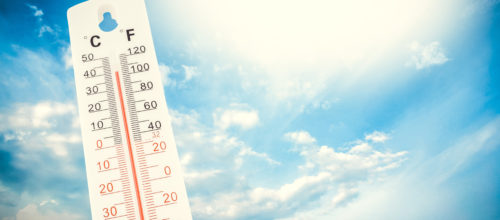
How to Stay Safe during a Summer Workout
The warm weather, water, and beautiful skies make it inviting time of year for an outdoor workout. Individuals that are not previously acclimatized to exercising in the heat should use caution, however, because while the elevated body temperature associated with summer exercise may provide a fitness boost, it also increases the risk for heat cramps, exhaustion and stroke. Therefore, before you go outside to break a sweat, make sure you know how to stay safe while exercising.
- Drink up!
-
- Drink 16-24 ounces of water 2-3 hours before exercise and take in about 6-8 ounces every 20 minutes during exercise. Water is recommended for moderate activity but if the exercise is rigorous, a sports drink may be needed to restore lost electrolytes.
- Monitor the humidity:
-
- In a humid environment (like everyday for the past month!), sweat will not evaporate and cool off the body as fast, putting you at a higher risk for heat illness. Therefore, when the weather is both hot and humid, try to work out indoors instead.
- Avoid certain times:
-
- 10am- 3pm is when the sun is the hottest and UV rays are strongest. Early mornings are typically the most enjoyable for exercise. It will usually be the coolest at this time and it will get you up and ready to tackle the day ahead. If you are not a morning person, later in the evening can be an option as well.
- Protect yourself from the sun:
-
- Any time you go outdoors you should be applying sunscreen of SPF 30+ to ensure you will be protected from the harmful UV rays of the sun. Make sure to apply approx. 15 minutes before going outdoors, and don’t forget to reapply, especially after sweating. Also, always wear loose, light-colored clothing that enable the body to sweat and deflect sun.
- Never push yourself:
-
- Training in the heat is typically recommended for previously conditioned athletes. If you are not yet acclimated to exercising in the heat, but are looking to get outside and get moving, the safest way to start is to decrease the intensity or duration of your normal exercise routine. Work within your limits and never push yourself to the point of blurring, dizziness or feeling faint.
Some common signs and symptoms of heat illness to be aware of include:
· Confusion
· Dizziness
· Fainting
· Fatigue
· Headache
· Muscle or abdominal cramps
· Nausea, vomiting
· Dark colored urine
If you experience any of these symptoms stop physical activity, move to a cool place, put cool, wet cloths on your body, and sip water. Seek medical attention immediately if any of these symptoms worsen or last longer than 1 hour.
